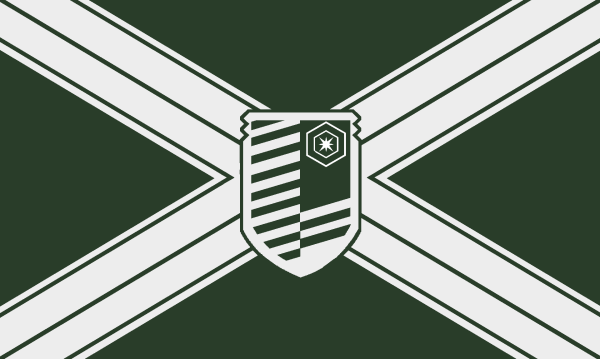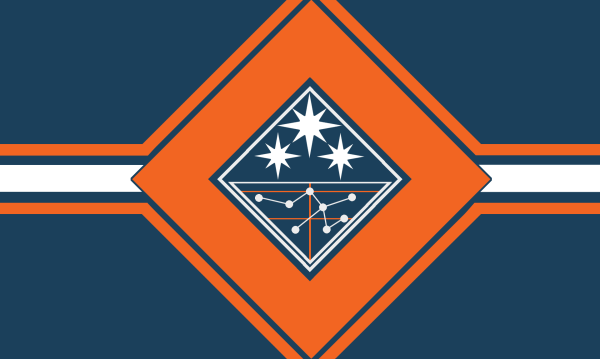Factions: Difference between revisions
No edit summary |
|||
| (One intermediate revision by the same user not shown) | |||
| Line 2: | Line 2: | ||
== Shelter Alliance == | == Shelter Alliance == | ||
[[File:Alliance | [[File:Alliance flag.png|thumb|600px]] | ||
The Alliance is a loose federation of 13 different local governments, administering 26 major populated planets across 17 star systems, as well as numerous minor colonies all located within its borders. It is a relatively young entity, formed approximately 400 years ago as a mutual defense pact between the three founding systems in response to aggression from the neighboring Venuma Coalition, which eventually developed into a full government. While most galactic nations have mixes of different cultures within their borders, the Alliance is unique on the galactic stage in that it has no core dominant culture, with many planets being so different from each other that a casual observer might not believe they belong to the same nation. | The Alliance is a loose federation of 13 different local governments, administering 26 major populated planets across 17 star systems, as well as numerous minor colonies all located within its borders. It is a relatively young entity, formed approximately 400 years ago as a mutual defense pact between the three founding systems in response to aggression from the neighboring Venuma Coalition, which eventually developed into a full government. While most galactic nations have mixes of different cultures within their borders, the Alliance is unique on the galactic stage in that it has no core dominant culture, with many planets being so different from each other that a casual observer might not believe they belong to the same nation. | ||
| Line 12: | Line 12: | ||
== Outlying Systems Protectorate == | == Outlying Systems Protectorate == | ||
[[File:OSP | [[File:OSP flag.png|thumb|600px]] | ||
A minor political faction within the Alliance government, the Protectorate is a singular entity consisting of 8 worlds across 3 systems prior to Integration. The OSP is considered one of the oldest constituent entities in the Alliance and lies on the furthest rimward edge of Alliance space, not abutting any other border. Their distance from inter-empire borders, trade, and conflict have left the OSP systems as an afterthought in many Alliance dealings and they are rarely patrolled by official military elements. | A minor political faction within the Alliance government, the Protectorate is a singular entity consisting of 8 worlds across 3 systems prior to Integration. The OSP is considered one of the oldest constituent entities in the Alliance and lies on the furthest rimward edge of Alliance space, not abutting any other border. Their distance from inter-empire borders, trade, and conflict have left the OSP systems as an afterthought in many Alliance dealings and they are rarely patrolled by official military elements. | ||
Depending more on each other than the seldom assistance of the Alliance, the Protectorate practices the timeless idea of succeeding through one's own perseverance. While it's certain that no one on the galactic stage refers to the Alliance as culturally homogenous, the OSP's relative isolation and combined history has resulted in the cluster retaining much of its internal loyalties and often operates as a unified front in Alliance politics. Their sense of self-reliance has garnered an identity as outsiders to the rest of the Alliance worlds, and Protectorate leadership is more than happy to maintain this image as it benefits their goals of independence. | Depending more on each other than the seldom assistance of the Alliance, the Protectorate practices the timeless idea of succeeding through one's own perseverance. While it's certain that no one on the galactic stage refers to the Alliance as culturally homogenous, the OSP's relative isolation and combined history has resulted in the cluster retaining much of its internal loyalties and often operates as a unified front in Alliance politics. Their sense of self-reliance has garnered an identity as outsiders to the rest of the Alliance worlds, and Protectorate leadership is more than happy to maintain this image as it benefits their goals of independence. | ||
The central authority of the OSP, known as the Conclave, is the collective term for the 8 representatives of the OSP worlds, known as "Barons | The central authority of the OSP, known as the Conclave, is the collective term for the 8 representatives of the OSP worlds, known as "Barons", who convene to discuss economic, infrastructural, and military matters. It is widely known that the Protectorate views the Alliance as "stale" and no longer necessary, as the external threats it was originally founded to counter have since shifted significantly. In their view, they provide far more to the Alliance than they receive back in benefits, and seek to return to a fully autonomous nation. Due to the geography of the Alliance and the difficulty of hyperspace travel without access to the Gates, political pundits often remark that the OSP simply wants to avoid paying their share while exploiting the protection the Alliance provides them simply by being a physical buffer from the rest of the populated galaxy. | ||
The OSP's worlds are entirely self-sufficient in terms of food and common resource production, but they lack the high-level manufacturing of the Core worlds. In spite of this, their resourcefulness and solidarity can be seen in their fleet; what they lack in major shipyards they make up for in creative appropriation of retired Alliance vessels, as well as retrofitted freighters and mining haulers. Their fleet doctrines rely heavily on the use of these retrofitted civilian ships as brawlers - able to throw a punch but not take one - in such large numbers they exploit and overwhelm the more methodical tactics of the Alliance Navy, while reserving their few proper warships for command and control. | The OSP's worlds are entirely self-sufficient in terms of food and common resource production, but they lack the high-level manufacturing of the Core worlds. In spite of this, their resourcefulness and solidarity can be seen in their fleet; what they lack in major shipyards they make up for in creative appropriation of retired Alliance vessels, as well as retrofitted freighters and mining haulers. Their fleet doctrines rely heavily on the use of these retrofitted civilian ships as brawlers - able to throw a punch but not take one - in such large numbers they exploit and overwhelm the more methodical tactics of the Alliance Navy, while reserving their few proper warships for command and control. | ||
Latest revision as of 15:31, 8 March 2023
There are currently two factions in NEBULOUS: Fleet Command: The Shelter Alliance and the Outlying Systems Protectorate.
Shelter Alliance
The Alliance is a loose federation of 13 different local governments, administering 26 major populated planets across 17 star systems, as well as numerous minor colonies all located within its borders. It is a relatively young entity, formed approximately 400 years ago as a mutual defense pact between the three founding systems in response to aggression from the neighboring Venuma Coalition, which eventually developed into a full government. While most galactic nations have mixes of different cultures within their borders, the Alliance is unique on the galactic stage in that it has no core dominant culture, with many planets being so different from each other that a casual observer might not believe they belong to the same nation.
Member states are mostly autonomous, but Alliance-wide policy is created and disseminated by a political body known as the Core Conference (or "the Core"), which is formed by legislators appointed by the individual member governments according to population. Up-and-coming politicians regularly argue that the weak associations between the members, with no strong central authority, is a recipe for disaster down the line, but the last 4 centuries have seen little conflict from within. The ease of relocation between planets and changes of citizenship for those who are not content where they are, combined with the difficulty of rigid administration across interstellar space without strong force, has left this camp as one of the Alliance's most minor parties.
All members contribute to the common defense of the Alliance's borders by providing ships and crews for the combined Fleets. For most of the Alliance's history, member states have provided their own fleet ships of indigenous design and the crews to man them. Most Alliance crews were not integrated between planets, with most spacers - at least, those not working at the Fleet Command level - spending their entire careers serving with only people from their home world or system. The challenge of managing the repairs, shipyard schedules, modernization plans, and parts inventories for the slew of different ships left many a Depot commander burnt out after only a year and strained Fleet Logistics continuously.
It was only in the last 150 years that Alliance Navy Fleet Command undertook a standardization initiative and commissioned the design of a set of warship hulls across all of the core ship classes to reduce these logistics challenges. These new hulls have steadily replaced the older mixed designs as they reached the end of their useful lives. While it is still not uncommon to see unique designs about the Fleet, they are becoming rarer.
Outlying Systems Protectorate
A minor political faction within the Alliance government, the Protectorate is a singular entity consisting of 8 worlds across 3 systems prior to Integration. The OSP is considered one of the oldest constituent entities in the Alliance and lies on the furthest rimward edge of Alliance space, not abutting any other border. Their distance from inter-empire borders, trade, and conflict have left the OSP systems as an afterthought in many Alliance dealings and they are rarely patrolled by official military elements.
Depending more on each other than the seldom assistance of the Alliance, the Protectorate practices the timeless idea of succeeding through one's own perseverance. While it's certain that no one on the galactic stage refers to the Alliance as culturally homogenous, the OSP's relative isolation and combined history has resulted in the cluster retaining much of its internal loyalties and often operates as a unified front in Alliance politics. Their sense of self-reliance has garnered an identity as outsiders to the rest of the Alliance worlds, and Protectorate leadership is more than happy to maintain this image as it benefits their goals of independence.
The central authority of the OSP, known as the Conclave, is the collective term for the 8 representatives of the OSP worlds, known as "Barons", who convene to discuss economic, infrastructural, and military matters. It is widely known that the Protectorate views the Alliance as "stale" and no longer necessary, as the external threats it was originally founded to counter have since shifted significantly. In their view, they provide far more to the Alliance than they receive back in benefits, and seek to return to a fully autonomous nation. Due to the geography of the Alliance and the difficulty of hyperspace travel without access to the Gates, political pundits often remark that the OSP simply wants to avoid paying their share while exploiting the protection the Alliance provides them simply by being a physical buffer from the rest of the populated galaxy.
The OSP's worlds are entirely self-sufficient in terms of food and common resource production, but they lack the high-level manufacturing of the Core worlds. In spite of this, their resourcefulness and solidarity can be seen in their fleet; what they lack in major shipyards they make up for in creative appropriation of retired Alliance vessels, as well as retrofitted freighters and mining haulers. Their fleet doctrines rely heavily on the use of these retrofitted civilian ships as brawlers - able to throw a punch but not take one - in such large numbers they exploit and overwhelm the more methodical tactics of the Alliance Navy, while reserving their few proper warships for command and control.
 Hooded Horse Wikis
Hooded Horse Wikis

